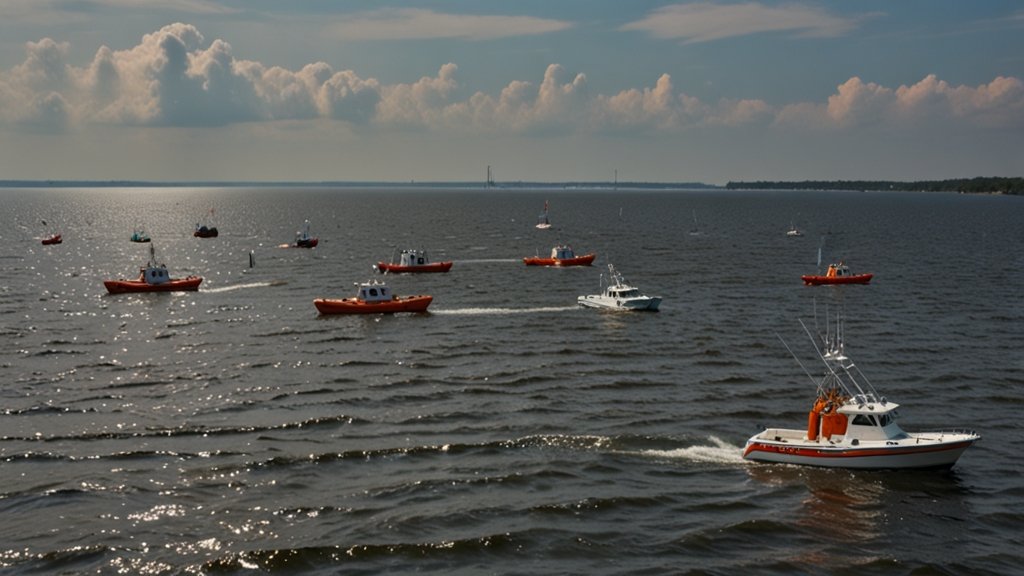Imagine the scene: A gleaming 122-foot Italian superyacht, a symbol of opulence and engineering prowess, slicing through the waters of the Chesapeake Bay on a summer afternoon. Sunlight dances off its polished hull. Inside, comfort reigns supreme. Now, imagine that scene shattered by blaring alarms and the terrifying realization that this floating palace is rapidly, inexplicably, sinking. This isn’t a Hollywood script; it was the stark reality on July 27, 2024, when the $8 million yacht capsizes near Annapolis, sending shockwaves through the maritime community and offering a sobering lesson about the sea’s unpredictable power.
The vessel, aptly named Lovebug, met its sudden fate near the mouth of the West River, roughly eight miles south of Maryland’s historic sailing capital, Annapolis. Valued at approximately $8 million, this luxury craft wasn’t some aging tub; it represented the pinnacle of modern yachting. Yet, in a matter of moments, it transformed from a haven of leisure into a foundering hazard. Reports indicate the yacht began taking on water unexpectedly, triggering chaos onboard. The captain’s swift actions – issuing a mayday call and expertly guiding all five occupants into shallower water – were nothing short of heroic. Thanks to a rapid response from nearby Good Samaritans on other vessels and coordinated emergency crews, everyone was pulled to safety miraculously unharmed. While the human story ended thankfully, the mystery of the Lovebug‘s rapid demise had just begun.
The Incident Unfolds: Panic, Precision, and Rescue
The Chesapeake Bay, especially near Annapolis in late July, is typically bustling with recreational boaters enjoying the summer warmth. For those aboard the Lovebug, the day likely started with relaxation and scenic views. That tranquility evaporated abruptly.
- The Sudden Onset: Without warning, the yacht began taking on significant amounts of water. The cause remains under investigation, but the effect was immediate and severe. Internal alarms would have sounded, piercing the calm.
- Captain’s Critical Response: Facing a potential catastrophe, the captain demonstrated exceptional presence of mind. Two crucial actions defined the next minutes:
- Distress Call: An urgent radio mayday was broadcast, alerting authorities and nearby vessels to the emergency.
- Strategic Maneuvering: Understanding the imminent danger of sinking in deep water, the captain deliberately steered the listing vessel towards shallower ground near the West River mouth. This decision was pivotal, creating a safer environment for evacuation and preventing the yacht from sinking completely into deep, difficult-to-access depths.
- Community & Emergency Mobilization: The maritime community’s “see something, say something” ethos shone. Nearby boats, hearing the distress call or witnessing the unfolding drama, raced to assist. Simultaneously, local fire departments, police marine units, and the Coast Guard launched a coordinated rescue operation.
- Successful Evacuation: As the yacht settled in the shallows, listing heavily or partially capsized, the five individuals onboard were successfully transferred to rescue craft. The speed and coordination of the response ensured no serious injuries were reported – a testament to training and preparedness.
Containing the Crisis: Environmental Vigilance
A capsized or sunken vessel isn’t just a navigational hazard; it’s an environmental threat. A yacht the size of the Lovebug carries substantial amounts of fuel, oil, and potentially other hazardous materials.
- Immediate Containment: Recognizing this danger, authorities swiftly deployed protective measures. Boom containment systems – floating barriers designed to trap pollutants – were likely encircled around the site to prevent any leaking diesel or oil from spreading into the sensitive Chesapeake Bay ecosystem.
- Ongoing Monitoring: Environmental response teams would have begun continuous monitoring of the water surrounding the wreck for any signs of sheen or contamination, ready to deploy additional cleanup resources if necessary. Protecting the Bay’s health is paramount in such incidents.
The Million-Dollar Question: Why Did the Lovebug Sink?
An $8 million superyacht doesn’t just spring a catastrophic leak without reason. These vessels are built with multiple watertight compartments, sophisticated bilge pumping systems, and rigorous safety standards. The formal investigation, likely involving the Coast Guard, National Transportation Safety Board (NTSB), and potentially insurance surveyors, will meticulously examine:
- Hull Integrity: Was there a structural failure? A collision with a submerged object (like a log or container)? Damage from prior grounding?
- Systems Failure: Could a critical through-hull fitting (valves where pipes pass through the hull) have failed? Did a sea chest (intake for engine cooling) rupture? Was there a catastrophic failure in the propulsion system or associated piping?
- Human Factors: While the captain’s actions during the crisis were exemplary, could there have been procedural errors beforehand? Was maintenance up to date on critical systems?
- Design or Manufacturing Flaw: Though less common in established builders, this possibility must be explored, especially if similar incidents have occurred with the same model.
Common Causes of Sudden Sinking in Large Yachts
| Cause Category | Specific Examples | Preventative Measures |
|---|---|---|
| Hull Damage | Collision (submerged object, dock), Grounding, Stress fracture, Corrosion failure | Vigilant navigation, Updated charts/depth sounders, Regular hull surveys & maintenance |
| Through-Hull Failure | Seacock (valve) failure, Broken fitting, Hose rupture | Regular inspection/replacement of critical valves/hoses, Emergency plugs/stoppers onboard |
| Stern Gear Issues | Rudder stock failure, Propeller shaft seal rupture, Strut damage | Regular inspection of seals/bearings, Monitoring for unusual vibrations, Proper alignment |
| Deck/Superstructure | Large wave swamping, Door/hatch left open or failing in heavy seas | Secure all openings in rough weather, Ensure scuppers (deck drains) are clear |
| Internal Flooding | Major plumbing rupture (AC, watermaker), Tank failure | Regular system checks, High-water alarms in all bilge areas |
Also Read: www.goodmooddotcom.com Cruising Category: Your Gateway to Luxury & Tailored Sea Adventures
Salvage: The Complex Task of Raising an $8 Million Giant
Recovering a vessel as large and valuable as the Lovebug from the Chesapeake Bay floor is a major logistical operation fraught with challenges.
- Assessment: Salvage experts first needed to conduct thorough underwater surveys using divers and remotely operated vehicles (ROVs) to assess the yacht’s exact position, orientation, structural integrity, and potential environmental hazards (like trapped fuel).
- Planning: A detailed salvage plan had to be formulated. This involves choosing the right equipment (massive floating cranes, specialized lift bags, powerful pumps) and determining the safest method to right the vessel (if capsized), dewater it, and lift it onto a barge or tow it to a shipyard.
- Execution: The actual salvage is high-risk. Factors like weather, tides, currents, and the stability of the wreck itself all play critical roles. The priority is always to minimize further environmental damage and ensure the safety of the salvage crew.
- Cost & Complexity: Salvaging a superyacht can easily run into the hundreds of thousands, if not millions, of dollars. It requires highly specialized skills and equipment.
The Uncomfortable Truth: Luxury ≠ Invincibility
The $8 million yacht capsizes near Annapolis incident serves as a stark, high-profile reminder of a fundamental truth often obscured by polished teak and powerful engines: The sea is an inherently unforgiving environment.
- Complex Systems = Complex Failures: Modern superyachts are marvels of engineering, but they are also incredibly complex networks of mechanical, electrical, and hydraulic systems. A single point of failure in a critical system can cascade into disaster.
- Vigilance is Non-Negotiable: This event underscores the absolute necessity of rigorous, routine maintenance by qualified technicians, adherence to safety protocols by crew and guests, and constant vigilance while underway. Complacency has no place on the water.
- Preparation Saves Lives: The positive outcome here – no lives lost – is directly attributable to the captain’s training, quick thinking, and the existence of robust emergency response systems (both onboard and within the local maritime community). It highlights the life-or-death importance of regular safety drills, proper emergency equipment (EPIRBs, life rafts, immersion suits), and knowing how to use them.
- Respect the Environment: The swift environmental response also demonstrates the critical importance of protecting our waterways. A major fuel spill could have had devastating consequences for the Chesapeake Bay’s fragile ecosystem and local economies.
Lessons for Every Mariner (Big or Small)
While few of us command $8 million yachts, the core lessons from the Lovebug incident resonate with anyone who ventures onto the water:
- Maintenance is Paramount: Never skip scheduled maintenance. Pay special attention to through-hull fittings, hoses, bilge pumps, and structural components. Document everything.
- Know Your Systems: Understand how your boat works. Know where the seacocks are, how the bilge pumps operate (manually and automatically), and how to isolate flooding if possible.
- Practice Emergency Procedures: Conduct regular man-overboard and abandon-ship drills. Ensure everyone onboard knows where life jackets are and how to use safety equipment. Familiarize yourself with your VHF radio and distress procedures.
- File a Float Plan: Always let someone reliable know where you’re going, who’s with you, and when you expect to return.
- Invest in Safety Gear: Ensure you have working and accessible life jackets for everyone, fire extinguishers, flares, a sound-producing device, a first-aid kit, and a functioning VHF radio at minimum. Consider an EPIRB or PLB for offshore excursions.
- Respect the Water: Never underestimate the power of the marine environment. Check weather forecasts religiously before heading out and while underway. Conditions can change rapidly.
The Investigation Awaits: Seeking Answers on the Chesapeake
As salvage teams work to recover the Lovebug, the formal investigation continues. Marine surveyors and investigators will pore over the wreckage, interview the crew, analyze maintenance records, and reconstruct the events leading up to the sudden flooding. The findings will be crucial, not just for determining liability or insurance claims, but for enhancing safety protocols across the industry and potentially preventing similar incidents in the future. The question of how such a well-equipped and valuable vessel succumbed so quickly remains the central puzzle.
Conclusion
The image of the capsized Lovebug, a stark silhouette against the Chesapeake Bay near Annapolis, is a powerful one. It shatters the illusion of invincibility that often surrounds such magnificent machines. The $8 million yacht capsizes near Annapolis incident is ultimately a story of human resilience and effective response saving lives, but it’s also an indelible reminder of nature’s dominance. It underscores that safety on the water is not guaranteed by price tags or prestige, but by relentless preparation, meticulous maintenance, unwavering vigilance, and a deep respect for the immense power of the sea. Whether you’re aboard a superyacht or a skiff, the principles of seamanship remain the same: respect the water, prepare diligently, and never stop learning.
Actionable Takeaways for Safer Boating:
- Schedule That Survey: Don’t delay your next hull or mechanical survey. It’s an investment in safety.
- Test Your Pumps: Manually test your bilge pumps today. Ensure automatic switches are functioning. Clean strainers.
- Locate Your Seacocks: Know where every through-hull is and ensure you have emergency plugs/stoppers readily accessible nearby.
- Refresh Your Drills: Conduct a safety drill on your next outing – even if it’s just reviewing procedures with your crew/family.
- Check Your Gear: Inspect life jackets, flares, fire extinguishers, and your VHF radio. Replace expired items immediately.
You May Also Read: Travel Tweaks Offers: Little Changes That Unlock Big Adventures
FAQs
What exactly happened to the yacht?
On July 27, 2024, the 122-foot superyacht Lovebug suddenly began taking on water near the West River mouth, about 8 miles south of Annapolis, MD. It capsized or foundered as a result. All five people onboard were rescued safely.
Why did such an expensive yacht sink?
The exact cause is under active investigation by authorities (like the Coast Guard and NTSB). Potential causes being examined include hull damage (from collision or grounding), failure of a critical through-hull fitting or valve, catastrophic systems failure (like ruptured piping), or potentially a structural issue. Luxury doesn’t eliminate the risk of mechanical failure.
Were there any injuries or environmental damage?
Miraculously, all five people onboard were rescued without serious injuries, thanks to the captain’s actions and a swift emergency response. Authorities deployed containment booms immediately and are monitoring the site closely; significant environmental damage has been reported as contained so far, but the investigation and salvage will continue to assess this.
How do you salvage a yacht that big?
Salvaging a superyacht is complex and costly. It involves detailed underwater surveys, specialized equipment like massive floating cranes or lift bags, careful planning to right the vessel (if capsized), pump it out, and then lift it onto a barge or prepare it for towing to a shipyard. Safety and environmental protection are top priorities.
What does this mean for yacht safety?
This incident is a stark reminder that no vessel is immune to catastrophic failure. It emphasizes the critical importance of rigorous, routine maintenance by qualified professionals, thorough crew training in emergency procedures, constant vigilance while underway, and having reliable, accessible safety equipment on board – regardless of the boat’s size or value.
Where can I find updates on the investigation?
Official updates will likely come from the US Coast Guard Sector Maryland-National Capital Region and the National Transportation Safety Board (NTSB). Local news outlets covering Annapolis and the Chesapeake Bay region will also report on significant developments.
Could this happen to any boat?
While the scale might differ, the fundamental types of failures that led to this incident (hull breach, fitting failure, systems malfunction) can potentially affect any vessel. The core lessons about maintenance, preparation, and vigilance apply universally to all boaters.











